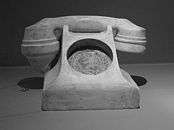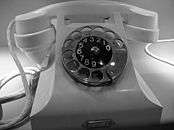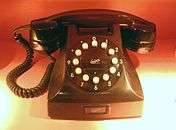Ericsson DBH 1001 telephone

The Bakelite phone, officially known as Ericsson DBH 1001, and later as M33, N1020, and ED 702, was a Swedish line of telephones made from the polymer Bakelite and produced for over thirty years between 1931 and 1962.
History
The Ericsson DBH 1001 of 1931 was a collaborative project between the Elektrisk Bureau in Oslo, LM Ericsson and Televerket (Sweden). It was designed by electrical engineer Christian Bjerknes and Norwegian artist Jean Heiberg. It was the first Bakelite phone with integral cradle, dial and ringer, and was very modern for its time.
Until the early 1930s, the housing of the Swedish phone models was made from pressed steel. Material change from steel to Bakelite brought new opportunities in design, while also reducing the production time for the housing. The Bakelite phone was not only compact but also light at just below 3kg, and could be grasped by one hand.
Design
The device with its simple, curved angular design became an instant hit with the industry as well as the consumers, and was highly influential. In most of Europe, it was called the Swedish type of telephone and in the United Kingdom, where the unit had been supplemented with a slide-out phone block, it was known as the Cheesedish.
Variants
Already in the mid 1930s, Ericsson showed a white Bakelite phone in advertisements, often in the hands of a young woman. However, this model seems never to have been offered to the public. At the 1939 World Fair in New York City, Ericsson showed a transparent variant made of acrylic and diakon plastic.
The standard color of the phone was black, but there were also variants in drab brown, red, and green. The process of using Bakelite did not permit the production of bright colors. The device was manufactured from 1933 in a smaller format, and from 1947 redesigned with softer, more rounded edges as the model designated M50. It was also offered in white melamine. The metal dial rotor was replaced with a plastic version, and a spiral cord became standard.
During 1950, Ericsson also experimented with a keypad version, instead of the rotary dial, but it would take another ten years before they became standard in Swedish phones. In 1962, the Bakelite Phone was replaced by the Ericsson Dialog model.
Images
-

Clay model 1930
-

White melamine 1935
-

model DBH 1001 (bottom plate) 1939
-

Revised with softer lines 1947-62
-

Experiment with keypad